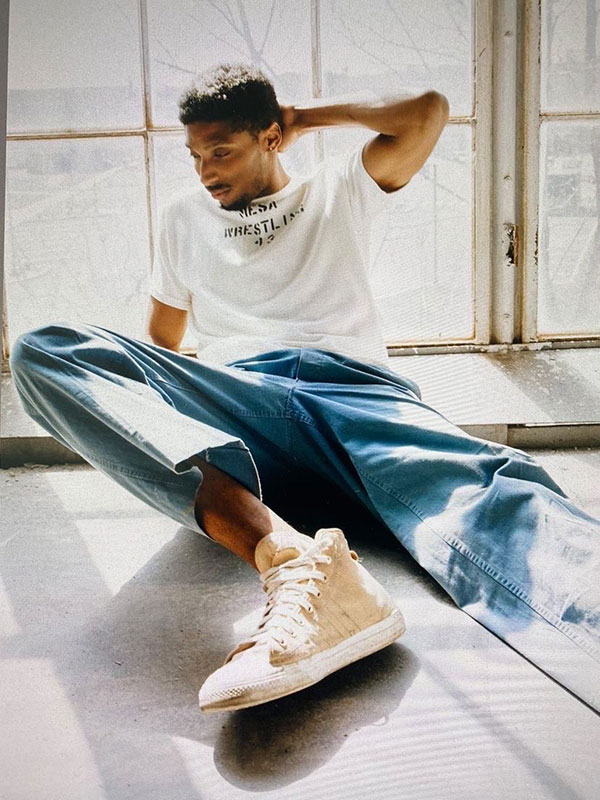Experimentation is an important part of an artist’s studio practice; stepping outside of your main focus and venturing outside of your comfort zone with unfamiliar materials and unrelated art fields has the potential for tremendous growth as an artist.
- 1 min. short (denim designs)
- 1 min. short (denim skirt)
- 1 min. short (shoe design)
- 1 min. short (T-shirt stencil)
- 1 min. short (apron & skirt)
- 1 min. short (wallpaper design)
- 1 min. short (lamp design)
- 1 min. video (fashion ideas)
- 39 min. video (discussion)
- Design Curriculum
- Industrial Design playlist
- Fashion Design playlist
Discussed are the various fields Cat and Dorian have explored despite their focus on graphic novels (Cat) and Industrial Design.
For Dorian this included upcycle fashion, silkscreening, installation, sculpture, and more. For Cat this included lithography, metalsmithing, animatics, and 3D Design.
Discussion with Art Prof Clara Lieu, Cat Huang, and guest artist Dorian Epps.
Guest Artist
Dorian Epps
Dorian is an Experiential and Product Designer from Pittsburgh, Pennsylvania. As a graduate from Rhode Island School Design, he received his BFA in Industrial Design.

His love for basketball and footwear have inspired him to design and establish a sportswear and streetwear brand — Blacktop Market — that aims to highlight the intersections of basketball and sport in everyday life and culture.
Through his creative endeavors he seeks to explore the capabilities of storytelling and the connectedness of people. With this in mind, his aim is to explore and produce events and products that create and emphasize identity and community.
Video Walkthrough
- Industrial Design is a field that people commonly are not aware of, or at least recognizing.
- People interact with Industrial Design every day: the soda can you are drinking out of, a book shelf, a shoe, are all examples of industrial design.
- Industrial Design can be described as “everything in a house that is not alive.”
- Artists often experience pressure to hyper focus on one practice or field.
- Stepping outside of your field, and doing something that is totally unrelated is a great way to keep your studio practice fresh and to keep growing as an artist.
- At times trying something that is not your main focus as be liberating, as you don’t have the same expectations going into it given your lack of experience.
- Dorian’s interest in upcycle fashion has many correlations into his experience with industrial design.
- Dorian created a shoe that was constructed from parts of 6 other shoes.
- Trying out new things as an artist means being willing to ask for help from someone to learn a new technique.
- In many art fields there can be gatekeeping about what industrial design is “supposed to be,” what illustration has to look like, etc.
- A lot of creating pieces outside of your regular studio practice is knowing how to see the potential in a material that perhaps was tossed aside.
- Dorian’s shop, Black Top Market explores the various intersections of sport, identity, and culture.
- Once you have tried a new technique, a new material, you always have to ability to dive right back into it.
- The initial hurdle of getting the supplies and techniques you need to get started is usually what is the toughest part.
- Regardless of your field as an artist, learning how to identify your audience, what needs you want to address in your audience is very important.
- Cat’s animatic has many fundamental ideas and elements that are also seen in her graphic novels.
- The animatic had voice acting and storyboarding, all very much related to the graphic novel Cat is working on.
Prof Lieu’s Tips

I always price according to the venue. Selling at a gallery is a totally different price point than if I were selling in my online shop.

You can definitely do well with lower prices and therefore selling at a higher volume. I had sooooo many old gesture drawings of figures that were just lying around, so I figured I would throw them up for sale.
I think I priced them $50 each (this was I think 10 years ago) and I had a lot of people who would buy 3 or 4 at a time.

As a free educational source, Art Prof uses Amazon affiliate links (found in this page) to help pay the bills. This means, Art Prof earns from qualifying purchases.










